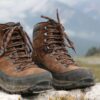Guidebooks
Foremost amongst the English guidebooks is John Brierley’s book:
 A Pilgrim’s guide to the Camino de Santiago
A Pilgrim’s guide to the Camino de Santiago
‘Now updated to include newer maps and photos – and lighter in weight to support carefree traveling – this comprehensive guidebook to the Camino de Santiago and its offshoots contains all the information needed by modern-day pilgrims wishing to walk the sacred Way of St. James. Overview route planners plus daily stage maps and detailed town plans help sojourners with all the advance preparation they need. The maps feature contour guides to help distinguish the terrain that will be crossed each day, while full information on all pilgrim hostels, as well as details for alternative accommodation, allow travelers to plot adequate nightly stopping points. All reference information is accompanied by helpful spiritual guidelines to support the seeker’s inner journey as well as the outer pilgrimage. Otherwise known as the Camino Frances, the main route covered in this volume is the most popular sacred route through Spain, from St. Jean Pied de Port to Santiago’. Also available for the Portuguese Camino.
Other useful books include:
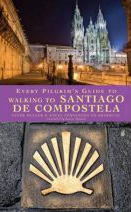 Walking to Santiago de Compostela
Walking to Santiago de Compostela
This edition is co-published with the Confraternity of St James, the UK’s leading organisation for promoting pilgrimage to Santiago. A mix of practical information and spiritual inspiration for walkers, it offers a stage-by-stage guide pointing out places of interest along the way; practical tips for walkers; prayers, blessings and spiritual exercises to nourish the pilgrim spirit and deepen the pilgrimage experience.
It is illustrated throughout with maps and photographs, and conveniently pocket sized.
 Call of the Camino
Call of the Camino
The experiences of an ordinary man on the pilgrim’s path are charted in this narrative that walks along the Camino Frances to the shrine of Saint James at Santiago de Compostela and then on to Finisterre, the westernmost point of Spain. The history of the Camino is recounted, as well as several of the myths, legends, and miracle stories that have become attached-and given special meaning-to this itinerary.
Emphasizing that personal myths are an essential part of this lore, this chronicle also includes stories from the confraternity of the pilgrims, people from all corners of the world who visit this walk for a great diversity of reasons, but all of whom leave having experienced the same miracle-that this pilgrimage will play a defining role in their lives.
 A Slow Walk Across Spain
A Slow Walk Across Spain
‘Whether you’ve already decided to take time out to walk this ancient path, or are just thinking about it, A Slow Walk Across Spain is full of inspiration, practical information and an exploration of the history of the Camino de Santiago.
It includes kit lists, diary excerpts, local recipes and beautiful images from Karen’s two Caminos, as well as a removable map and lists of useful websites and reading materials’.
Karen is Melbourne based so you’ll get an Australian perspective (see also her courses listed under Camino Courses).
 Walking the Camino
Walking the Camino
Filled with fascinating observations and anecdotes about the nature of contemporary Spain, this intriguing account tells the story of Tony Kevin, an overweight 63-year-old former diplomat who set off on an eight-week trek across the country armed only with a small rucksack and a staff. Rich with the history, politics, and culture of the region, this travel narrative follows two of the many pilgrim trails that crisscross Spain and Portugal and lead to Santiago de Compostela.
By retelling Kevin’s journey, it delves into what drives tens of thousands of people of all nationalities and creeds to make long, exhausting walks across the cold mountains and hot tablelands of Spain. In addition to cultural and spiritual discussions, this diverse exploration also offers practical advice for would-be pilgrims–from packing and training to walking techniques and navigation.
 Hiking the Camino de Santiago
Hiking the Camino de Santiago
‘Hiking the Camino de Santiago contains all the information you need to walk the 800km (500 miles) Camino Francés and 90km (55 miles) Camino Finisterre.
Full-color detailed topographical stage maps of each day s walk, GPS files online-100+ detailed city and town maps to make sure you always know where you are. Essential practical information on transport, accommodations and services.
Overviews of dozens of historic pilgrim sites, with information about the historical context of the pilgrimage-Expert advice on hiking gear, packing and daily camino life’.
 The Edible Camino
The Edible Camino
“The Edible Camino” guidebook features 77 wild edible plants and mushrooms found along the Camino de Santiago in Spain. Written by pilgrims, for pilgrims, the pages are packed with detailed plant descriptions, vivid photographs, annotated sketches, nutritional/medicinal information, and 50 wild vegan and vegetarian recipes.
Although the book focuses on the Camino Francés in Spain, the majority of the selected species are found abundantly in other parts of Europe, the Mediterranean, and North America, making “The Edible Camino” an excellent introductory guidebook to wild foods no matter where you walk.
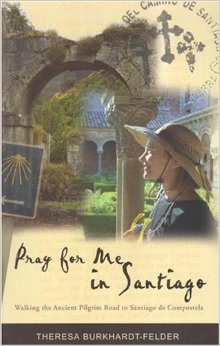 Pray for me in Santiago
Pray for me in Santiago
Art historian Conrad Rudolph follows the ancient pilgrim route to Santiago de Compostela. With anecdotes, travel tips and scholarly descriptions of medieval art, he offers a thoughtful guide to a remarkable journey across northern Spain one undertaken by thousands of pilgrims each year. Very well researched and worth the persistence.
The author chose to stay in hotels rather than the refugios giving an accurate and valuable perspective from a middle aged walker.
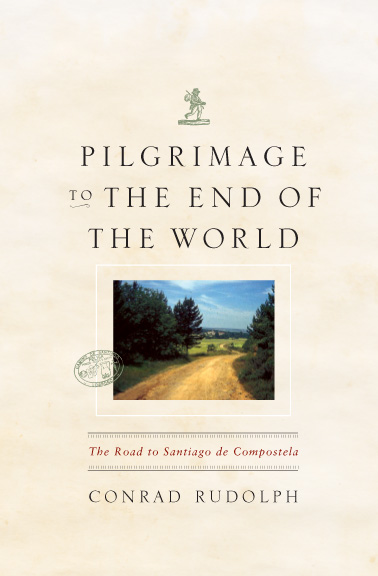 Pilgrimage End to the World
Pilgrimage End to the World
Traveling two and a half months and one thousand miles along the ancient route through southern France and northern Spain, Conrad Rudolph made the passage to the holy site of Santiago de Compostela, one of the most important modern-day pilgrimage destinations for Westerners.
In this chronicle of his travels to this captivating place, Rudolph melds the ancient and the contemporary, the spiritual and the physical, in a book that is at once travel guide, literary work, historical study, and memoir.
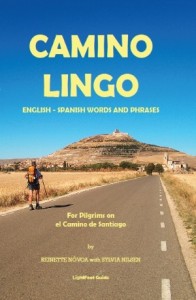 Camino Lingo
Camino Lingo
If you only take one Spanish phrase book or dictionary with you on the Camino this is it! No complicated verb conjugations or rules on diphthongs and grammar. This is a ‘cheats’ guide to speaking Spanish on the Camino. Over 650 English/Spanish words relating specifically to the Camino pilgrimage with simplified pronunciation – including a few curse words should you need them!
The Pilgrimage Road to Santiago: The Complete Cultural guide to the Camino – David M. Gitlitz & Linda K. Davidson
A step by step guide to the cultural history of the Camino. Reviews each towns’ historical significance to the Camino along with covering aspects of the terrain, history and artistic monuments. It is considered by many to be an indispensible guide to researching the Camino.
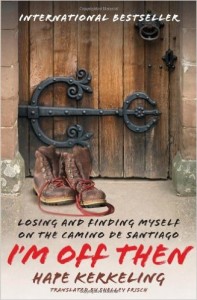 I’m off then: Losing and finding myself on the Camino de Santiago – Hape Kerkeling
I’m off then: Losing and finding myself on the Camino de Santiago – Hape Kerkeling
Overweight, overworked, and disenchanted, Kerkeling was an unlikely candidate to make the arduous pilgrimage along the Camino. But he decided to get off the couch and do it anyway. Lonely and searching for meaning along the way, he began the journal that turned into this utterly frank, engaging book. Filled with unforgettable characters, historic landscapes, and Kerkeling’s self-deprecating humour, this is a highly recommended read. This book is considered one of the reasons there has been a large increase in the number of walkers on the Camino in recent years.
To the field of stars: A pilgrim’s journey to Santiago de Compostela – Kevin A. Codd
This is another personal journey; the record of a man seeking to take stock of his life and the profound changes that occurred from walking the Camino. This is a hugely popular and moving book.
Paris to the Pyrenees: A Skeptic Pilgrim walks the Way of Saint James – David Downie
A very well reviewed book; this is an unusual take on the Pilgrimage from a non- religious point of view. This book is a journey through France along the ancient byways that underpin the Camino and then onto the Camino itself. Beautifully illustrated with excellent photographs of the scenery along the route.
The Best Way – El Camino de Santiago – Bill Walker
Well known for his books on hiking the Appalachian Trail and the Pacific Crest trail this is the authors take on the Camino. Undertaking the Camino in the holy year of 2010, with his 11 year old nephew for light relief, this is the author’s perspective on all the international characters he met along the way, the journey itself as well as a review of the history of the Camino.
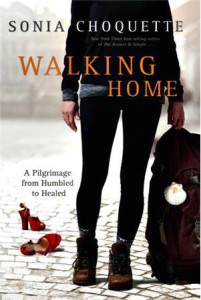 Walking Home – Sonia Choquette
Walking Home – Sonia Choquette
Just before internationally acclaimed, spiritual author and intuitive Sonia Choquette turned 50, she lost all the key men in her life. Her father and brother both died unexpectedly, and her husband left her as well — all within a six week period. She dropped into a deep, dark state, and none of her old, spiritual “coping tools” were helping. So she did what she’s best at: she turned to spirit and asked what she should do. The answer she got was this: walk the Camino de Santiago Pilgrimage in Spain.
 A Food Lover’s Pilgrimage to Santiago de Compostela – Dee Nolan
A Food Lover’s Pilgrimage to Santiago de Compostela – Dee Nolan
This joyful book tells the story of Dee’s camino, of the pilgrimage itself and of the food traditions that sustain us all. Following the route of those first pilgrims, Dee met wise cooks and farmers who are finding that the future lies in the past. And she realised why, in our secular age, we are so captivated by this medieval Christian pilgrimage.
Love ‘em or hate ‘em – the next 3 books are both loved and disliked in equal measure; you will have to make your own mind up about them!
The Camino: A Journey of the Spirit – Shirley Maclain – a personal account of her journey – along with her out of body experiences – on the Camino when it was at its nadir in the 80’s.
Travels with my Donkey; One Man and his Ass on the Camino de Santiago –Tim Moore .Funny but deeply irreverent account of one man’s journey with his donkey along the Camino
The Pilgrimage – Paul Cohelo This one is mostly loved! It is based on his journey along the Camino and is told of as a tale of mystery and suspense with as usual deeper spiritual meaning. This was the foundation for his hugely popular book The Alchemist.






